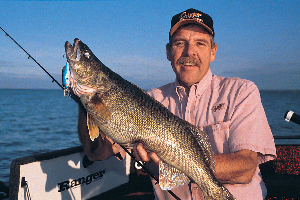Ask the Walleye Pro: Richard Lacourse

Q: What is a planer board and what is its purpose? I see guys using them for trolling but I don’t understand the advantage.
-Dale Kingsland, Hayward, Wis.
A: An In-line planer board is a devise used for trolling that helps you get your baits out and away from the side of the boat to help you catch fish that might easily get spooked. As the boat moves through the water, the displacement of water, and sometimes noise from the motor, causes fish to move out to the sides of the boat as you pass by.
The number one reason that side planers are used is to quickly cover a lot of water. Using planer boards makes fishing with numerous rods much easier too, because it allows you to place baits at different depths and several yards apart from each other while on the same side of the boat. Using planer boards takes a little practice, but once you get the hang of it, they are a fun tool to help you catch more fish.
Q: What do you believe is the best live bait for catching walleyes? I do a lot of drifting and bottom-bouncing with 1/8 ounce jigs. I have friends that swear by minnows, but I prefer leeches.
-Bruce Fitts, Davenport, Iowa
A: The question should actually read, “What do walleyes believe is the best live bait?”
I like leeches, minnow, and night crawlers, and I’m prepared to use all three on any given day of fishing. I cannot limit myself to one particular bait when it comes to knowing what the fish will want.
I’ve seen the fish’s mood change for live bait throughout the course of a day. There have also been times when the fish would hit plastics better than they would live bait. I keep an assortment of Gulp baits handy, just for that occasion when the fish are hitting plastics better. The product is quite remarkable when it comes to smelling and tasting like live bait, and the best part is that it won’t die unless you leave the package open. It’s a water based product, so it will dry out and shrivel up if you leave the package open.
Q: What type of line do you prefer to use? I’ve used mono my entire life, but I’ve heard many of the pros now use fluorocarbon. Could you explain the differences and the advantages of each?
-Chris Teel, Chamberlain, S.D.
A: It can be very confusing when you go into a sporting goods store to buy line, and you see all the line choices available these days. When it comes to choosing a line, whether it’s mono, braided, hi-visibility, a superline, or fluorocarbon, its important to know where you will be fishing and what techniques and presentations you will be using. I don’t feel there is just one line to cover all the applications effectively.
When choosing a line I look at the location I’m going to be fishing and what action I want to produce. If I’m trolling open water, I like to use a mono because of the added stretch it gives while fighting fish.
When I’m running smaller baits, or I’m troubled with a lot of weeds fouling my baits, I like to use Fireline. Fireline is a no-stretch line, and the smaller diameter allows me to add approximately 20 percent to the dive curve of any bait I use. Because of the no-stretch qualities, it’s easy to read the vibration in the rod tip, or lack there of, when the bait is fouled, letting me know I need to check my bait.
Fluorocarbon lines have come a long way in a short period of time. The qualities that make fluorocarbon so special is the fact that it’s virtually invisible under water. This line is a little more expensive than regular mono lines, but sometimes spending that extra money pays off. I tend to only use fluorocarbon line in clear water conditions, or when I’m fishing spooky fish. Stained waters are more forgiving and you can usually get away with using a less expensive mono line for those applications.
Rick Lacourse is a veteran walleye angler who has fished the Wal-Mart FLW Walleye Tour, Professional Walleye Trail and Master’s Walleye Circuit. The Port Clinton, Ohio, resident won the 1997 PWT Championship and finished in fourth place at the 2004 RCL Championship. Lacourse’s favorite walleye technique is trolling crankbaits. Lacourse’s wife, Julia Davis, also fishes as a pro on the FLW Walleye Tour. Lacourse’s sponsors include Ranger Boats, Evinrude, Minn Kota, Gemini Sport Marketing, Off Shore Tackle, Panther Marine Products, Dixie Marine, Clamps, Inc.